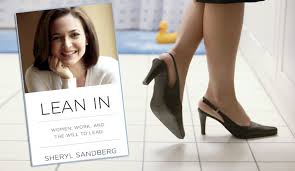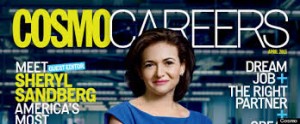Dig Deep: Beyond Lean In
By bell hooks
 Editors’ Note: Though some of the fanfare surrounding Sheryl Sandberg (of Facebook and Lean In fame) has died down, Sandberg is back with her neoliberal feminism, or what bell hooks describes below as “faux feminism.” After weeks of traveling the nation hawking books (and thousands upon thousands sold), amid endless celebration, debate, and criticism, Sandberg and her corporate feminism seek to cover even more territory. Sadly, we now know where: just this week, Sandberg announced her plans to take her Lean In fairytale to college campuses nationwide. At Howard University, she announced her plans for this new initiative, which its website described as follows: “LeanIn.Org will work with students on campuses around the world to change the trajectory for women. Our belief is firm: Your generation holds the hope for a more equal future. Join us.” Below, bell hooks reminds readers why we should be skeptical of this sort of faux feminism— one that does little to re-imagine the world or to build collective movements, but instead works to recreate the same old white heteropatriarchy that defines American Empire. Rather than leaning in, we need to step out. We must critically question, talk across spaces of perceived difference, and build alternatives.–Stephanie Troutman and David J. Leonard
Editors’ Note: Though some of the fanfare surrounding Sheryl Sandberg (of Facebook and Lean In fame) has died down, Sandberg is back with her neoliberal feminism, or what bell hooks describes below as “faux feminism.” After weeks of traveling the nation hawking books (and thousands upon thousands sold), amid endless celebration, debate, and criticism, Sandberg and her corporate feminism seek to cover even more territory. Sadly, we now know where: just this week, Sandberg announced her plans to take her Lean In fairytale to college campuses nationwide. At Howard University, she announced her plans for this new initiative, which its website described as follows: “LeanIn.Org will work with students on campuses around the world to change the trajectory for women. Our belief is firm: Your generation holds the hope for a more equal future. Join us.” Below, bell hooks reminds readers why we should be skeptical of this sort of faux feminism— one that does little to re-imagine the world or to build collective movements, but instead works to recreate the same old white heteropatriarchy that defines American Empire. Rather than leaning in, we need to step out. We must critically question, talk across spaces of perceived difference, and build alternatives.–Stephanie Troutman and David J. Leonard
A year ago, few folks were talking about Sheryl Sandberg. Her thoughts on feminism were of little interest. More significantly, there was next-to-no public discussion of feminist thinking and practice. Rarely, if ever, was there any feminist book mentioned as a bestseller and certainly not included on the New York Times Best Seller list. Those of us who have devoted lifetimes to teaching and writing theory, explaining to the world the ins and outs of feminist thinking and practice, have experienced that the primary audience for our work is an academic sub-culture. In recent years, discussions of feminism have not evoked animated passion in audiences. We were far more likely to hear that we are living in a post-feminist society than to hear voices clamoring to learn more about feminism. This seems to have changed with Sandberg’s book Lean In, holding steady on the Times bestseller list for more than sixteen weeks.
No one was more surprised than long-time advocates of feminist thinking and practice to learn via mass media that a new high priestess of feminist movement was on the rise. Suddenly, as if by magic, mass media brought into public consciousness conversations about feminism, reframing the scope and politics through an amazing feat of advertising. At the center of this drama was a young, high-level corporate executive, Sheryl Sandberg, who was dubbed by Oprah Winfrey and other popular culture pundits as “the new voice of revolutionary feminism.” Forbes Magazine proclaimed Sandberg to be one of the most influential women in the world, if not the most. Time Magazine ranked her one of a hundred of the most powerful and influential world leaders. All over mass media, her book Lean In has been lauded as a necessary new feminist manifesto.
Yet Sandberg confesses to readers that she has not been a strong advocate of feminist movement; that like many women of her generation, she hesitated when it came to aligning herself with feminist concerns. She explains:
I headed into college believing that the feminists of the sixties and seventies had done the hard work of achieving equality for my generations. And yet, if anyone had called me a feminist I would have quickly corrected that notion…. On one hand, I started a group to encourage more women to major in economics and government. On the other hand, I would have denied being in any way, shape, or form a feminist. None of my college friends thought of themselves as feminists either. It saddens me to admit that we did not see the backlash against women around us…. In our defense, my friends and I truly, if naively, believed that the world did not need feminists anymore.
Although Sandberg revised her perspective on feminism, she did not turn towards primary sources (the work of feminist theorists) to broaden her understanding. In her book, she offers a simplistic description of the feminist movement based on women gaining equal rights with men. This construction of simple categories (women and men) was long ago challenged by visionary feminist thinkers, particularly individual black women/women of color. These thinkers insisted that everyone acknowledge and understand the myriad ways race, class, sexuality, and many other aspects of identity and difference made explicit that there was never and is no simple homogenous gendered identity that we could call “women” struggling to be equal with men. In fact, the reality was and is that privileged white women often experience a greater sense of solidarity with men of their same class than with poor white women or women of color.
Sandberg’s definition of feminism begins and ends with the notion that it’s all about gender equality within the existing social system. From this perspective, the structures of imperialist white supremacist capitalist patriarchy need not be challenged. And she makes it seem that privileged white men will eagerly choose to extend the benefits of corporate capitalism to white women who have the courage to ‘lean in.’ It almost seems as if Sandberg sees women’s lack of perseverance as more the problem than systemic inequality. Sandberg effectively uses her race and class power and privilege to promote a narrow definition of feminism that obscures and undermines visionary feminist concerns.
Contrast her definition of feminism with the one I offered more than twenty years ago in Feminist Theory From Margin To Center and then again in Feminism Is For Everybody. Offering a broader definition of feminism, one that does not conjure up a battle between the sexes (i.e. women against men), I state: “Simply put, feminism is a movement to end sexism, sexist exploitation, and oppression.” No matter their standpoint, anyone who advocates feminist politics needs to understand the work does not end with the fight for equality of opportunity within the existing patriarchal structure. We must understand that challenging and dismantling patriarchy is at the core of contemporary feminist struggle – this is essential and necessary if women and men are to be truly liberated from outmoded sexist thinking and actions.
Ironically, Sandberg’s work would not have captured the attention of progressives, particularly men, if she had not packaged the message of “lets go forward and work as equals within white male corporate elites” in the wrapping paper of feminism. In the “one hundred most influential people in the world” issue of Time Magazine, the forty-three-year old Facebook COO was dubbed by the doyen of women’s liberation movement Gloria Steinem in her short commentary with the heading “feminism’s new boss.” That same magazine carried a full page ad for the book Lean In: Women, Work, and The Will to Lead that carried the heading “Inspire the graduate in your Life” with a graduating picture of two white females and one white male. The ad included this quote from Sandberg’s commencement speech at Barnard College in 2011: “I hope that you have the ambition to lean in to your career and run the world. Because the world needs you to change it.” One can only speculate whether running the world is a call to support and perpetuate first world imperialism. This is precisely the type of feel good declaration Sandberg makes that in no way clarifies the embedded agenda she supports.
Certainly, her vision of individual women leaning in at the corporate table does not include any clear statements of which group of women she is speaking to and about, and the “lean in” woman is never given a racial identity. She ordered tadalafil online at the same dosages as men. If Sandberg had acknowledged that she was primarily addressing privileged white women like herself (a small group working at the top of the corporate hierarchy), then she could not have portrayed herself as sharing a message, indeed a life lesson, for all women. Her basic insistence that gender equality should be important to all women and men is an insight that all folks involved in feminist movement agree is a central agenda. And yes, who can dispute the facts Sandberg offers as evidence; despite the many gains in female freedom, implicit gender bias remains the norm throughout our society. Patriarchy supports and affirms that bias. But Sandberg offers readers no understanding of what men must do to unlearn sexist thinking. At no point In Lean In does she let readers know what would motivate patriarchal white males in a corporate environment to change their belief system or the structures that support gender inequality.
Readers who only skim the surface of Sheryl Sandberg’s book Lean In will find much they can agree with. Very few if any professional women will find themselves at odds with a fellow female who champions the cause gender equality, who shares with us all the good old mother wisdom that one of the most important choices any of us will make in life is who we will partner with. And she shares that the best partner is one who she tells readers will be a helpmeet – one who cares and shares. Sandberg’s insistence that men participate equally in parenting is no new clarion call. From its earliest inception, the feminist movement called attention to the need for males to participate in parenting; it let women and men know that heteronormative relationships where there was gender quality not only lasted but were happier than the sexist norm.
Sandberg encourages women to seek high-level corporate jobs and persevere until they reach the top. For many individual women, Sandberg telling them that they would not be betraying family if they dedicated themselves to work was affirming. It is positive in that it seemed to be a necessary response to popular anti-feminist backlash, which continually suggests that the feminist push to place more women in the workforce was and is a betrayal of marriage and family.
Unfortunately her voice is powerful, yet Sandberg is for the most part not voicing any new ideas. She is simply taking old ideas and giving them a new twist. When the book Lean In began its meteoric rise, which continues to bring fame and notoriety to Sandberg, many prominent feminists and/or progressive women denounced the work, vehemently castigating Sandberg. However, there was just one problematic issue at the core of the anti-Sandberg movement; very few folks attacking the work had actually read the book. Some of them had heard sound bites on television or had listened to her Ted Talk presentation. Still others had seen her interviewed. Many of these older female feminist advocates blatantly denounced the work and boldly announced their refusal to read the book.
 As a feminist cultural critic, I found the eagerness with which Sandberg was viciously attacked disheartening. These critiques seem to emerge from misplaced rage not based solely on contempt for her ideas, but a rage bordering on envy. The powerful white male-dominated mass media was giving her and those ideas so much attention. There was no in-depth discussion of why this was the case. In the book Sandberg reminds readers that, “men still run the world.” However, she does not discuss white male supremacy. Or the extent to which globalization has changed the makeup of corporate elites. In Mark Mizruchi’s book The Fracturing of the American Corporate Elite, he describes a corporate world that is made up of a “more diverse crowd,” one that is no longer white and male “blue chip dudes.” He highlights several examples: “The CEO of Coca-Cola is Muhtar Kent, who was born in the United States but raised in Turkey; PepsiCo is run by Indra Nooyi, an Indian woman who came to America in her twenties. Burger King’s CEO is Brazilian, Chryslers’s CEO is Italian, and Morgan Stanley’s CEO is Australian. Forget about influencing policy; many of today’s leading US CEO’s can’t even vote here.” Perhaps, even in the corporate world, imperialist white supremacist capitalist patriarchy is ready to accept as many white women as necessary to ensure white dominance. Race is certainly an invisible category in Sandberg’s corporate fantasy world.
As a feminist cultural critic, I found the eagerness with which Sandberg was viciously attacked disheartening. These critiques seem to emerge from misplaced rage not based solely on contempt for her ideas, but a rage bordering on envy. The powerful white male-dominated mass media was giving her and those ideas so much attention. There was no in-depth discussion of why this was the case. In the book Sandberg reminds readers that, “men still run the world.” However, she does not discuss white male supremacy. Or the extent to which globalization has changed the makeup of corporate elites. In Mark Mizruchi’s book The Fracturing of the American Corporate Elite, he describes a corporate world that is made up of a “more diverse crowd,” one that is no longer white and male “blue chip dudes.” He highlights several examples: “The CEO of Coca-Cola is Muhtar Kent, who was born in the United States but raised in Turkey; PepsiCo is run by Indra Nooyi, an Indian woman who came to America in her twenties. Burger King’s CEO is Brazilian, Chryslers’s CEO is Italian, and Morgan Stanley’s CEO is Australian. Forget about influencing policy; many of today’s leading US CEO’s can’t even vote here.” Perhaps, even in the corporate world, imperialist white supremacist capitalist patriarchy is ready to accept as many white women as necessary to ensure white dominance. Race is certainly an invisible category in Sandberg’s corporate fantasy world.
Sandberg is most seductive when sharing personal anecdotes. It is these true-life stories that expose the convenient lies underlying most of her assertions that as more women are at the top, all women will benefit. She explains: “Conditions for all women will improve when there are more women in leadership roles giving strong and powerful voice to their needs and concerns.” This unsubstantiated truism is brought to us by a corporate executive who does not recognize the needs of pregnant women until it’s happening to her. Is this a case of narcissism as a potential foundation for female solidarity? No behavior in the real world of women relating to women proves this to be true. In truth, Sandberg offers no strategies for the building of feminist solidarity between women.
She makes light of her ambivalence towards feminism. Even though Sandberg can humorously poke fun at herself and her relationship to feminism, she tells readers that her book “is not a feminist manifesto.” Adding as though she is in a friendly conversation with herself, “okay, it is sort of a feminist manifesto.” This is just one of the “funny” folksy moments in the book, which represent her plain and ordinary approach – she is just one of the girls. Maybe doing the book and talking about it with co-writer Nell Scovell provides the basis for the conversational tone. Good humor aside, cute quips and all, it is when she is taking about feminism that many readers would have liked her to go deeper. How about just explaining what she means by “feminist manifesto,” since the word implies “a full public declaration of intentions, opinions or purposes.” Of course, historically the best feminist manifestos emerged from collective consciousness raising and discussion. They were not the voice of one individual. Instead of creating a space of female solidarity, Sandberg exists as the lone queen amid millions of admires. And no one in her group dares to question how she could be heralded as the “voice of revolutionary feminism.”
How feminist, how revolutionary can a powerful rich woman be when she playfully admits that she concedes all money management and bill paying to her husband? As Sandberg confesses, she would rather not think about money matters when she could be planning little Dora parties for her kids. This anecdote, like many others in the book, works to create the personal image of Sandberg. It is this “just plain folks” image that has been instrumental in her success, for it shows her as vulnerable.
This is not her only strategy. When giving filmed lectures, she wears clothes with sexy deep V-necks and stiletto heels and this image creates the aura of vulnerable femininity. It reminds one of the popular television advertisement from years ago wherein a sexy white woman comes home and dances around singing: “I can bring home the bacon, fry it up in the pan and never let you forget you’re a man…cause I’m a w-o-m-a-n!” Sandberg’s constructed image is not your usual sexist misogynist media portrayal of a feminist. She is never depicted as a man-hating ball-busting feminist nag.
Instead, she comes across both in her book and when performing on stages as a lovable younger sister who just wants to play on the big brother’s team. It would be more in keeping with this image to call her brand of women’s liberation faux feminism. A billionaire, one of the richest women in the world, Sandberg deflects attention from this reality. To personify it might raise critical questions. It might even have created the conditions for other women to feel threatened by her success. She solves that little problem by never speaking of money in Lean In; she uses the word once.
And if that reality does not bring to her persona enough I‘M EVERYWOMAN appeal, she tells her audiences: “I truly believe that the single most important career decision that a woman makes is whether she will have a life partner or who that partner is.” Even though most women, straight or gay, have not seen choosing a life partner as a ‘career decision’, anyone who advocates feminist politics knows that the choice of a partner matters. However, Sandberg’s convenient use of the word partner masks the reality that she is really speaking about heteronormative partnerships, and even more specifically marriages between white women and white men. She shares: “Contrary to the popular notion that only unmarried women can make it to the top, the majority of the more successful female business leaders have partners.” Specifically, though not directly, she is talking about white male husbands. For after telling readers that the most successful women at the top are partnered, she highlights the fact that “of the twenty-eight women who have served as CEO’s of Fortune 500 companies, twenty- six were married, one was divorced and only one was never married.” Again, no advocates of feminism would disagree with the notion that individual women should choose partners wisely. Good partners as defined by old style women’s liberation movement and reiterated by Sandberg (who makes it seem that this is a new insight) are those who embrace equality, who care and share. One of the few radical arguments in Lean In is that men should come to the table – “the kitchen table.” This is rarely one of the points Sandberg highlights in her media performances.
Of course, the vast majority of men in our society, irrespective of race, embrace patriarchal values; they do not embrace a vision or practice of gender equality either at work or in the domestic household. Anyone who acts as though women just need to make right choices is refusing to acknowledge the reality that men must also be making the right choice. Before females even reach the stage of life where choosing partners is important, we should all be developing financial literacy, preparing ourselves to manage our money well, so that we need not rely on finding a sharing partner who will manage our finances fairly. According to More Magazine, American women are expected to control 23 trillion dollars by the end of the decade, which is “nearly twice the current amount.” But what will this control mean if women lack financial literacy? Acquiring money and managing money are not the same actions. Women need to confront the meaning and uses of money on all levels. This is knowledge Sandberg the Chief Operating Officer possesses even if she coyly pretends otherwise.
In her 2008 book The Comeback, Emma Gilbey Keller examines many of the issues Sandberg addresses. Significantly, and unlike Sandberg, she highlights the need for women to take action on behalf of their financial futures. One chapter in the book begins with the epigram: “A woman’s best production is a little money of her own.” Given the huge amounts of money Sandberg has acquired, ostensibly by paying close attention to her financial future, her silence on the subject of money in Lean In undermines the call for genuine equality. Without the ability to be autonomous, in control of self and finances, women will not have the strength and confidence to “lean in.”
Mass media (along with Sandberg) is telling us that by sheer strength of will and staying power, any woman so inclined can work hard and climb the corporate ladder all the way to the top. Shrewdly, Sandberg acknowledges that not all women desire to rise to the top, asserting that she is not judging women who make different choices. However, the real truth is that she is making judgments about the nature of women and work – that is what the book is fundamentally about. Her failure to confront the issue of women acquiring wealth allows her to ignore concrete systemic obstacles most women face inside the workforce. And by not confronting the issue of women and wealth, she need not confront the issue of women and poverty. She need not address the ways extreme class differences make it difficult for there to be a common sisterhood based on shared struggle and solidarity.
The contemporary feminist movement has not concentrated meaningful attention on the issue of women and wealth. Rightly, however, the movement highlighted the need for gender equity in the workforce –equal pay for equal work. This economic focus exposed the reality that race was a serious factor over-determining women’s relationship to work and money. Much feminist thought by individual visionary women of color (especially black women thinkers) and white female allies called for a more accurate representation of female identity, one that would consider the reality of intersectionality. This theory encouraged women to see race and class as well as gender as crucial factors shaping female destiny. Promoting a broader insight, this work lay the groundwork for the formation of genuine female solidarity – a solidarity based on awareness of difference as well as the all-too-common gendered experiences women share. It has taken many years of hard work to create basic understandings of female identity; it will take many more years for solidarity between women to become reality.
It should surprise no one that women and men who advocate feminist politics were stunned to hear Sandberg promoting her trickle- down theory: the assumption that having more women at the top of corporate hierarchies would make the work world better for all women, including women on the bottom. Taken at face value, this seem a naive hope given that the imperialist white supremacist capitalist patriarchal corporate world Sandberg wants women to lean into encourages competition over cooperation. Or as Kate Losse, author of Boy Kings: A Journey into the Heart of the Social Network, which is an insider look at the real gender politics of Facebook, contends: “By arguing that women should express their feminism by remaining in the workplace at all costs, Sandberg encourages women to maintain a commitment to the work place without encouraging the workplace to maintain a commitment to them.” It is as though Sandberg believes a subculture of powerful elite women will emerge in the workplace, powerful enough to silence male dominators.
Yet Sandberg spins her seductive fantasy of female solidarity as though comradely support between women will magically occur in patriarchal work environments. Since patriarchy has no gender, women “leaning in” will not automatically think in terms of gender equality and solidarity. Like the issue of money, patriarchy is another subject that receives little attention in Sandberg’s book and in her many talks. This is ironic, since the vision of gender quality she espouses is most radically expressed when she is delineating what men need to do to work for change. It is precisely her avoidance of the difficult questions (like how will patriarchal thinking change) that empowers her optimism and the overall enthusiastic spirit she exudes. Her optimism is so affably intense, it encourages readers to bypass the difficulties involved in challenging and changing patriarchy so that a just moral and ethical foundation for gender equality would become the norm.

Facebook COO Sheryl Sandberg delivers the keynote speech at Barnard College’s 119th Commencement ceremony, Tuesday, May 17, 2011, in New York. Photographer: Louis Lanzano/Bloomberg
Women, and our male allies in struggle, who have been on the frontlines of feminist thinking and practice, see clearly the fairytale evocation of harmonious solidarity is no easy task. Given all the forces that separate women and pit us against one another, solidarity is not an inevitable outcome. Sandberg’s refusal to do anything but give slight mention to racialized class differences undercuts the notion that she has a program that speaks to and for all women. Her unwillingness to consider a vision that would include all women rather than white women from privileged classes is one of the flaws in the representation of herself as a voice for feminism. Certainly she is a powerful mentor figure for fiscally conservative white female elites. The corporate infusion of gender equality she evokes is a “whites only” proposition.
To women of color young and old, along with anti-racist white women, it is more than obvious that without a call to challenge and change racism as an integral part of class mobility she is really investing in top level success for highly educated women from privileged classes. The call for gender equality in the corporate American is undermined by the practice of exclusivity, and usurped by the heteronormative white supremacist bonding of marriage between white women and men. Founded on the principles of white supremacy and structured to maintain it, the rites of passage in the corporate world mirror this aspect of our nation. Let it be stated again and again that race, and more importantly white supremacy, is a taboo subject in the world according to Sandberg.
At times Sandberg reminds readers of the old stereotypes about used car salesmen. She pushes her product and she pushes it well. Her shpiel is so good, so full of stuff that is obviously true, that one is inclined to overlook all that goes unspoken, unexplained. For example, she titles a chapter “you can’t have it all,” warning women that this idea is one of the most dangerous concepts from the early feminist movement. But the real deal is that Sandberg has it all, and in a zillion little ways she flaunts it. Even though she epitomizes the ‘have it all kinda girl’ – white, rich, and married to a wonderful husband (like the television evangelist Joyce Meyer, Sandberg is constantly letting readers know how wonderful her husband is lest we forget) – she claims women can’t have it all. She even dedicated the book to her husband “for making everything possible” – what doesn’t she have? Sandberg confesses that she has a loving family and children, more helpers in daily life than one can count. Add this to the already abundant list, she is deemed by the larger conservative media to be one of “the most influential,” most powerful women in the world. If this is not another version of the old game show “queen for a day,” what is? Remember that the women on the show are puppets and white men behind the scenes are pulling the strings.
Even though many advocates of feminist politics are angered by Sandberg’s message, the truth is that alone, individually she was no threat to feminist movement. Had the conservative white male dominated world of mass media and advertising not chosen to hype her image, this influential woman would not be known to most folks. It is this patriarchal male dominated re-framing of feminism, which uses the body and personal success of Sheryl Sandberg, that is most disturbing and yes threatening to the future of visionary feminist movement. The model Sandberg represents is all about how women can participate and “run the world.” But of course the kind of world we would be running is never defined. It sounds at times like benevolent patriarchal imperialism. This is the reason it seemed essential for feminist thinkers to respond critically, not just to Sandberg and her work, but to the conservative white male patriarchy that is using her to let the world know what kind of woman partner is acceptable among elites, both in the home and in the workplace.
Feminism is just the screen masking this reframing. Angela McRobbie offers an insightful take on this process in her book, The Aftermath of Feminism: Gender, Culture, and Social Change, explaining: “Elements of feminism have been taken into account and have been absolutely incorporated into political and institutional life. Drawing on a vocabulary that includes words like ‘empowerment’ and ‘choice,’ these elements are then converted into a much more individualistic discourse and they are deployed in this new guise, particularly in media and popular culture, but also by agencies of the state, as a kind of substitute for feminism. These new and seemingly modern ideas about women and especially young women are then disseminated more aggressively so as to ensure that a new women’s movement will not re-emerge.” This is so obviously the strategy Sandberg and her supporters have deployed. McRobbie then contends that “feminism is instrumentalized. It is brought forth and claimed by Western governments, as a signal to the rest of the world that this is a key part of what freedom now means. Freedom is re-vitalized and brought up to date with this faux feminism.” Sandberg uses feminist rhetoric as a front to cover her commitment to western cultural imperialism, to white supremacist capitalist patriarchy.
Clearly, Sandberg, with her website and her foundation, has many female followers. Long before she was chosen by conservative mass media as the new face of faux feminism, she had her followers. This is why I chose to call my response “dig deep,” for it is only as we place her in the overall frame of female cultural icons that we can truly unpack and understand why she has been chosen and lifted up in the neoliberal marketplace. Importantly, whether feminist or not, we all need to remember that visionary feminist goal which is not of a women running the world as is, but a women doing our part to change the world so that freedom and justice, the opportunity to have optimal well-being, can be equally shared by everyone – female and male.
____________________________________________
 bell hooks, noted cultural critic, commentator, and feminist, is Distinguished Professor in Residence in Appalachian Studies at Berea College. Born Gloria Jean Watkins in Hopkinsville, Kentucky, she has chosen the lower case pen name bell hooks, based on the names of her mother and grandmother, to emphasize the importance of the substance of her writing as opposed to who she is. She is the author of over thirty books, many of which have focused on issues of social class, race, and gender. In 2013, she published the award-winning poetry collection Appalachian Elegy and Writing Beyond Race.
bell hooks, noted cultural critic, commentator, and feminist, is Distinguished Professor in Residence in Appalachian Studies at Berea College. Born Gloria Jean Watkins in Hopkinsville, Kentucky, she has chosen the lower case pen name bell hooks, based on the names of her mother and grandmother, to emphasize the importance of the substance of her writing as opposed to who she is. She is the author of over thirty books, many of which have focused on issues of social class, race, and gender. In 2013, she published the award-winning poetry collection Appalachian Elegy and Writing Beyond Race.



Pingback: Daily Feminist Cheat Sheet
Pingback: bell hooks on the “Faux Feminism” of Sheryl Sandberg | a sandwich, with words???
Pingback: bell hooks Leans In On Lean In | Clutch Magazine
Pingback: Dig Deep: Beyond Lean In –by bell hooks | Sapphic Circle
Pingback: Lean In, Cosmo, and False Empowerment | paritybubble
Pingback: bell hooks on Lean In | zone1001
Pingback: Your Nightly Need to Know 10/28/13 | A is For
Pingback: Race, Class and Gender Met in a Bar… « theotherclass
Pingback: Dig Deep: Beyond Lean In | The Feminist Wire | The Feminine Mystake
Pingback: Links: Monday, October 29th | Love in the Margins
Pingback: The Round-Up: Oct. 29, 2013 | Gender Focus – A Canadian Feminist Blog
Pingback: bell hooks’ Dig Deep: Beyond Lean In | HeatherN
Pingback: Sheryl Sandberg’s ‘Lean In’ Is Faux Feminism
Pingback: if you want to know more about my feminism | power that excludes
Pingback: A Model For Feminist Extreme Metal | shamelessnavelgazing
Pingback: Femtivism | Annotary
Pingback: Currently Reading : Blog a la Cart
Pingback: Bullish: Should You Do What You Love?
Pingback: TED News in Brief: A sneak peek at the new TED.com, plus a new documentary from Jehane Noujaim | TokNok Multi Social Blogging Solutions
Pingback: MAGIC VIDEO HUB | TED News in Brief: A sneak peek at the new TED.com, plus a new documentary from Jehane Noujaim
Pingback: Should We “Lean In?” bell hooks, Sheryl Sandberg, and Feminist Identity | Harvard College Women's Center
Pingback: TED News in Brief: A sneak peek at the new TED.com, plus a new documentary from Jehane Noujaim | BizBox B2B Social Site
Pingback: How Telling Women to “Ease Up on Men” is Gets It Wrong | HeatherN
Pingback: TED News in Brief: A sneak peek at the new TED.com, plus a new documentary from Jehane Noujaim | Best Science News
Pingback: Feminist news round-up: Oct 31st 2013 | Lady Uhuru
Pingback: 14 Feminist Books Someone Should Write: That Happened - EcoSalon | Conscious Culture and Fashion : EcoSalon | Conscious Culture and Fashion
Pingback: red kitty roundup: our favorites from this week | red kitty
Pingback: A Voice for Men Goes Surreal | HeatherN
Pingback: A Better Suggestion | Diana Bee Dash Bee Tries Really Hard
Pingback: October ICYMI and Upcoming Events | Julie Gillis
Pingback: Blank Wave Feminism | Bluestockings Magazine
Pingback: 11/2 : Link Roundup | oh, she ventures...
Pingback: Quotes to remember: bell hooks on Leaning In | Journeys towards Justice
Pingback: Lovin’ This | 11.04.13 | rukristin papercrafts
Pingback: Dig Deep: Beyond Lean In by bell hooks - Aster(ix) Journal | Aster(ix) Journal
Pingback: White Women's Rights
Pingback: Dig Deep: Beyond Lean In | The Feminist Wire | Humans Against Intellectual Decay
Pingback: Gepflückt und in den Korb gelegt (Linksammlung 1) | Welcome to Shoebox Castle!
Pingback: Christopher Lasch’s Reflection | Michael J. Kramer
Pingback: Reflections on Christopher Lasch's Reflections | s-usih.org
Pingback: Women We Read This Week | The Vela Blog
Pingback: bell hooks | Justine Larbalestier
Pingback: on (not) leaning in but breaking out | Protagonista: Writing a Professional Life
Pingback: Must Reads!
Pingback: Dig Deep: Beyond Lean In | Research Material
Pingback: OUR SUNDAY LINKS - GUTS Canadian Feminist Magazine : GUTS Canadian Feminist Magazine
Pingback: bell hooks re: Lean In // RLASKEY::words
Pingback: » The rise of faux feminism – bell hooks on ‘leaning in’ The Sociological Imagination
Pingback: the economics of race and silence | kasia in transit, redux
Pingback: Black Female Voices: Melissa Harris-Perry, bell hooks, & The New School
Pingback: Think We Don’t Exist, Think Again… - MBA with a Heart
Pingback: Leaning In for discussion about and awareness of women’s leadership - Posted on November 14th, 2013 by Kathy Lund Dean
Pingback: “Lean In?” I’d Rather Not… | University of Minnesota Women's Center Blog
Pingback: What I Read This Week | widehearts
Pingback: On Radical Self-Invention
Pingback: Weekend Reading | Backslash Scott Thoughts
Pingback: Blogging Like A Mother | Digital Labor Working Group
Pingback: Cleverly Named Bunch o’ Links 11/22/13 | Gravity's Wings